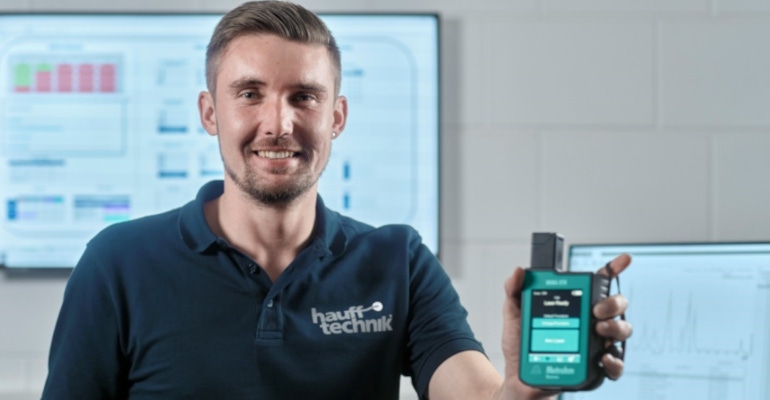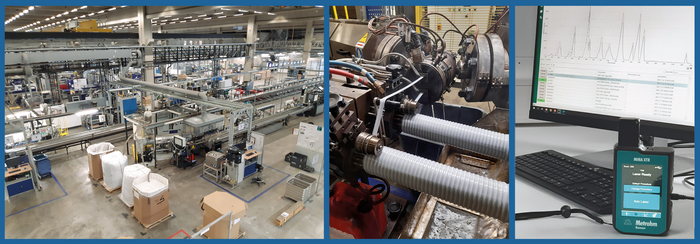Instant Polymer ID Verification Without a Lab?
QC team leader shows how he achieves this in under two minutes using non-destructive handheld Raman spectroscopy.
April 5, 2023

Sponsored by Metrohm
Roman Moser
Analysis and identification of polymers is essential to confirm not only the identity of an unknown polymer to verify that the proper material has been received prior to processing. Non-destructive analysis by Raman spectroscopy is an ideal solution; it allows you to perform quality checks on raw materials and products with no laboratory and chemistry required. It's a method that can ensure quality and reduce risk for producers, further processors, and all who work with plastics.
The following interview with Dr André Koch, Head of QC at Hauff-Technik, a leading German polymer processor. He explains the details and highlights the benefits of his team’s use of the MIRA XTR™ handheld Raman spectrometer from Metrohm.
Who is Hauff-Technik and what does your company do?
Hauff-Technik is one of the world’s leading manufacturers of cable, pipe, and line bushings. We are a good example of what we call Mittelstand in Germany — mid-sized companies from the manufacturing industry, which are often global market leaders.
Hauff-Technik is a hidden champion in that sense – yet also literally – as our products disappear into the concrete foundation when a house is built. Our products are made from polymer pellets supplied from the chemical industry that are fed into our extruders and blow molders in large quantities.
|
On the production floor at Hauff Technik in Hermaringen, Germany (left), bins of resin feed extruders that cast pipes on rotating cylinders (middle) — but not before a quick ID/quality check using Metrohm’s XTR DS. |
Why did you decide to invest in handheld Raman spectroscopy?
For a long time, we did not verify the ID of the polymer pellets that we get delivered from our suppliers at all. We simply relied on their certificates. To be fair, there was never an issue. However, simply believing in a certificate is just not in line with our philosophy here at Hauff-Technik.
We want to know exactly which materials we are processing. Investing in a chemical QC laboratory was out of the question. For us, handheld Raman spectroscopy was and is the solution. Our MIRA XTR is basically a laboratory in the palm of your hand – without the chemicals, reagents, and other materials usually needed for chemical analysis.
Colored substances are a challenge for Raman spectroscopy, as they are known to cause fluorescence resulting in a poor Raman signal. How do you deal with this challenge?
You see, that is the cool thing about MIRA XTR. We can extract a clear Raman signal even from the black polymer pellets that we process. What makes the difference is the XTR algorithm available in the MIRA Cal software, which is part of the MIRA XTR package. What is just a blurry slope before XTR is applied becomes a clear and unique fingerprint in the software thanks to the XTR algorithm. This fingerprint can then be matched against the spectrum of that particular polymer in the library of MIRA XTR for instant, unambiguous identification.
How long does it take from sampling to the result?
Sampling is very simple. We scoop some pellets from the batch that is waiting to be cleared to go on stock and pour them into a small vial. That sample vial is taken to the office, placed in a dedicated adapter of the MIRA XTR, and the analysis is performed by merely touching the instrument’s screen. Simple, fast, and clean —the sample is analyzed as-is.
Just one minute later, we can see the sample spectrum in the software and then compare it to the polymer it is expected to be by calling up the reference spectrum from the library. That is the cool thing about Raman spectroscopy and our MIRA XTR — anyone can use it; you don’t need to be a chemist to use this technology. So far, we’ve never had to reject a shipment that we received from a supplier – but you never know.
Would you recommend Raman spectroscopy and MIRA XTR specifically to polymer processors like Hauff-Technik?
Absolutely. You see, this requires some thinking outside the box. On one hand, investing in a QC laboratory often means too much of an overhead for a small or mid-sized company. On the other hand, these days you simply cannot afford to take risks when it comes to the integrity of your products, and ultimately your brand. With handheld Raman spectroscopy you can have your cake and eat it too, as it were: Instant chemical analysis and accurate results for your QC parameters at reasonable costs – without any laboratory needed!
About the author

Additional resources: For more information, read the article, "Identifying polymers with Raman spectroscopy,” for technical details; download a MIRA XTR brochure; and learn more about additional Raman Spectroscopy products. You may also visit www.metrohm.com or contact Metrohm USA's Adam Hopkins, PhD, at [email protected].
You May Also Like



